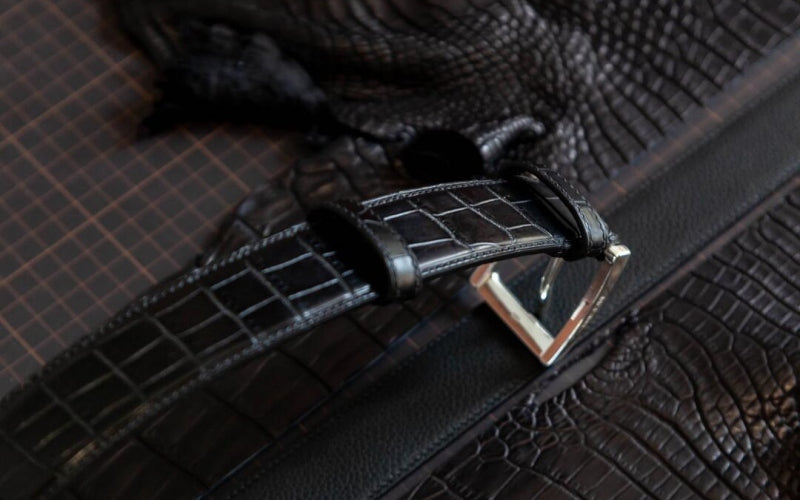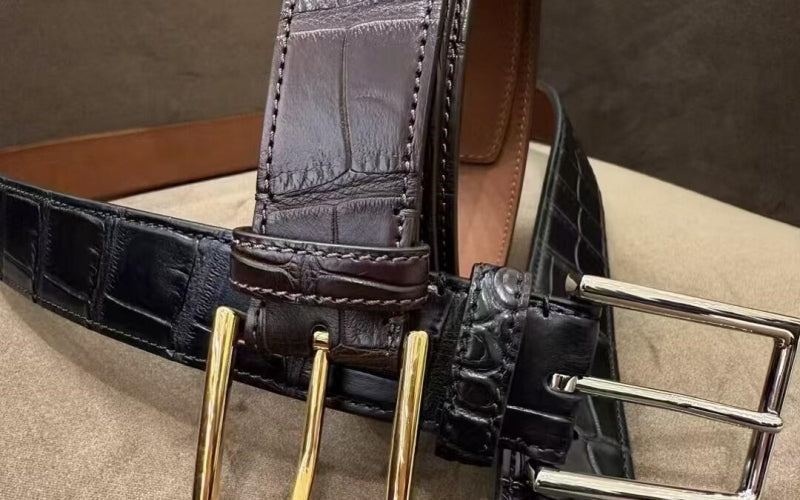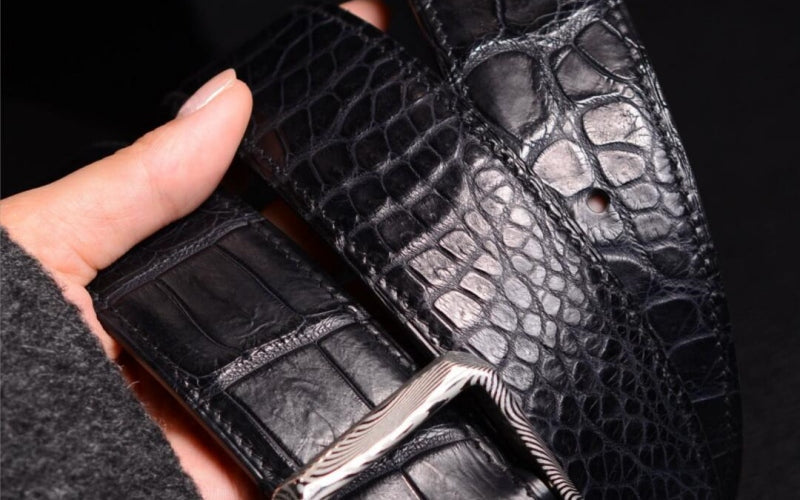
Are Alligator Leather Belts Durable? (Or Just a Fancy Way to Hold Up Your Pants?)
Hey there, luxury lovers and curious fashionistas! Let’s tackle the question that’s been slithering through your mind: Are alligator leather belts ACTUALLY durable, or are they just a pricey flex for your Instagram feed?
As someone who’s obsessed with both style and substance (and has a closet full of regrettable fashion experiments), I’ve cracked open the vault on all things exotic leather to give you the unvarnished truth.
By the end of this guide, you’ll know whether an alligator belt is a “buy it for life” investment or a delicate museum piece that crumbles if you sneeze too hard. Let’s dive in—and don’t worry, no actual alligators were harmed in the making of this blog.
 Dig this alligator belt? Check out the full collection by tapping the picture above
Dig this alligator belt? Check out the full collection by tapping the picture above
1. Alligator Leather 101: What Makes It So Special?
(Hint: It’s Not Just the Price Tag)
Before we talk durability, let’s break down why alligator leather is the Beyoncé of exotic materials:
The Skinny on Alligator Skin
-
Scale Pattern: Alligator hides have symmetrical, raised scales (called “osteoderms”) that look like tiny armor plates. This isn’t just for looks—it’s nature’s way of saying, “I’m built different.”
-
Flexibility: Unlike stiff cowhide, alligator leather is surprisingly pliable. Think of it as the yoga instructor of leathers—strong but supple.
-
Rarity: Farming alligators is heavily regulated (more on ethics later), which drives up the “oooh, fancy” factor.
Beltley’s Hot Take: Our Everglades Elite Belt uses Grade A alligator belly scales—the crème de la crème of hides.

2. Durability Decoded: Can Alligator Belts Survive Real Life?
Let’s cut to the chase: Yes, alligator leather belts are durable—IF you treat them right. Here’s why:
Factor #1: Natural Armor
Those osteoderms aren’t just pretty—they resist scratches and scuffs better than cowhide. Spill coffee on it? Wipe it off. Catch it on a door handle? Barely a mark.
Factor #2: Tanning Techniques
-
Chrome Tanning: Makes leather softer and water-resistant. Common in luxury brands.
-
Vegetable Tanning: Uses natural tannins for a firmer, eco-friendly finish. Less common but chef’s kiss for longevity.
Pro Tip: Ask your seller about the tanning process. Beltley’s alligator belts are veg-tanned for durability that lasts decades.
Factor #3: Thickness Matters
Alligator leather is typically split into layers. The full-grain belly cut (the thickest part) is your best bet for durability. Avoid paper-thin “fashion cuts” that belong on a handbag, not a belt.
 Dig this alligator belt? Check out the full collection by tapping the picture above
Dig this alligator belt? Check out the full collection by tapping the picture above
3. Alligator vs. Crocodile: The Ultimate Showdown
(Because Confusing Them is a Fashion Crime)
“Aren’t they the same thing?” Absolutely not. Here’s the tea:
-
Alligator: Smoother scales, U-shaped snout, farmed in the southern U.S.
-
Crocodile: Jagged scales, V-shaped snout, found in saltwater regions.
Durability Verdict: Crocodile leather is slightly thicker, but alligator’s flexibility makes it less prone to cracking. It’s like comparing a Lamborghini to a Ferrari—both elite, but one’s better for daily driving.
 Dig this alligator belt? Check out the full collection by tapping the picture above
Dig this alligator belt? Check out the full collection by tapping the picture above
4. The Dark Side: When Alligator Belts Fail
Even Superman has kryptonite. Here’s what can wreck your alligator belt:
-
Water Submersion: A little rain is fine, but don’t swim in it. Pro tip: Beltley’s Swamp Shield Spray adds a protective layer.
-
Sunbathing: UV rays fade colors and dry out the leather. Not a good look unless you’re going for “vintage chic.”
-
Cheap Craftsmanship: If the edges are painted (not burnished) or the stitching looks like a toddler’s art project, run.
True Story: A client once wore her alligator belt to a water park. It survived the slides but not her mother-in-law’s judgment.
 Dig this alligator belt? Check out the full collection by tapping the picture above
Dig this alligator belt? Check out the full collection by tapping the picture above
5. How to Care for Your Alligator Belt (So It Outlives Your Hobbies)
Treat it like a prized houseplant—minus the watering.
Step 1: Condition, Condition, Condition
Use a reptile-friendly leather conditioner every 6 months. Avoid oils—they can darken the skin.
Step 2: Store Like a Pro
-
Lay it flat in a dust bag (never hang—it’ll stretch like cheap yoga pants).
-
Keep it away from radiators, direct sunlight, and your cat’s claws.
Step 3: Clean Spills STAT
Wipe liquids with a dry cloth. For stubborn stains, use a damp cloth + mild soap. No harsh chemicals!
Beltley’s Secret: Our belts come with a free care kit because we know you’ll spill margaritas on it eventually.
 Dig this alligator belt? Check out the full collection by tapping the picture above
Dig this alligator belt? Check out the full collection by tapping the picture above
6. Ethical Sourcing: Because Fashion Shouldn’t Bite
Let’s address the elephant (or alligator) in the room: Is alligator leather ethical?
-
Regulations: In the U.S., alligator farming is tightly controlled under CITES. Farms support wetland conservation (gators are apex predators—their survival keeps ecosystems balanced).
-
Transparency: Reputable brands like Beltley provide traceability info. Ours come from Louisiana farms that’d make Dr. Phil proud.
Myth Buster: Wild alligator populations have rebounded because of regulated farming. Who knew fashion could save species?
7. Alligator vs. Cowhide: Which Wins the Durability Crown?
|
Factor |
Alligator |
Cowhide |
|
Scratch Resistance |
High (thanks to armored scales) |
Medium (picks up scuffs) |
|
Flexibility |
High (moves with you) |
Stiff (needs breaking in) |
|
Water Resistance |
Moderate (with care) |
Low (gets soggy) |
|
Lifespan |
20+ years |
10-15 years |
Winner: Alligator, but cowhide’s a solid budget backup.
Dig this alligator belt? Check out the full collection by tapping the picture above
8. FAQs: Your Burning Questions, Answered
Q: Can I wear an alligator belt daily?
A: Absolutely—if it’s high-quality. Rotate it with other belts to avoid wear.
Q: Do alligator belts crack?
A: Only if neglected. Condition it, and it’ll age like a Hollywood star.
Q: Why does alligator leather cost so much?
A: Farming is labor-intensive, and only 40% of hides pass quality checks. You’re paying for perfection.
9. Why Beltley’s Alligator Belts Are Worth the Splurge
Let’s be real: Not all alligator belts are created equal. Here’s why ours are the Tom Hanks of accessories—reliable, timeless, and universally loved:
-
Grade A Hides: Only the belly cuts (no back or tail scraps).
-
Hand-Stitched: Saddlestitching that laughs at weight fluctuations.
-
Ethical Swagger: Traceable sourcing + 1% of profits to wetland conservation.
Final Verdict: Are Alligator Leather Belts Durable?
YES—if you invest in quality craftsmanship, care for it like a Tamagotchi, and buy from a brand that respects the source.
Ready to Add Some Swamp Chic to Your Wardrobe? Slither over to Beltley’s Alligator Collection and snag a belt that’ll outlast your gym membership.
Because life’s too short for boring belts,
The Beltley Team


